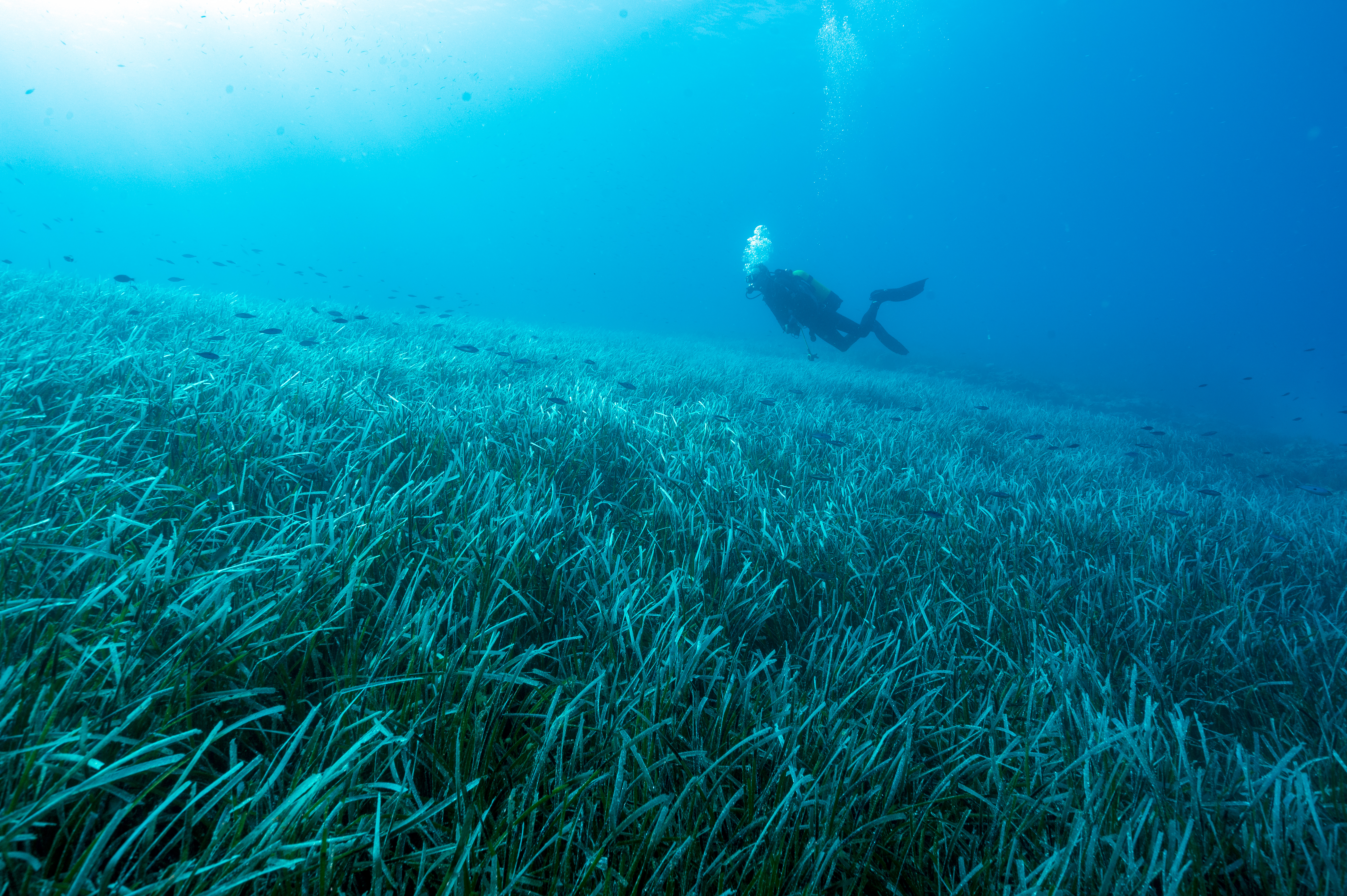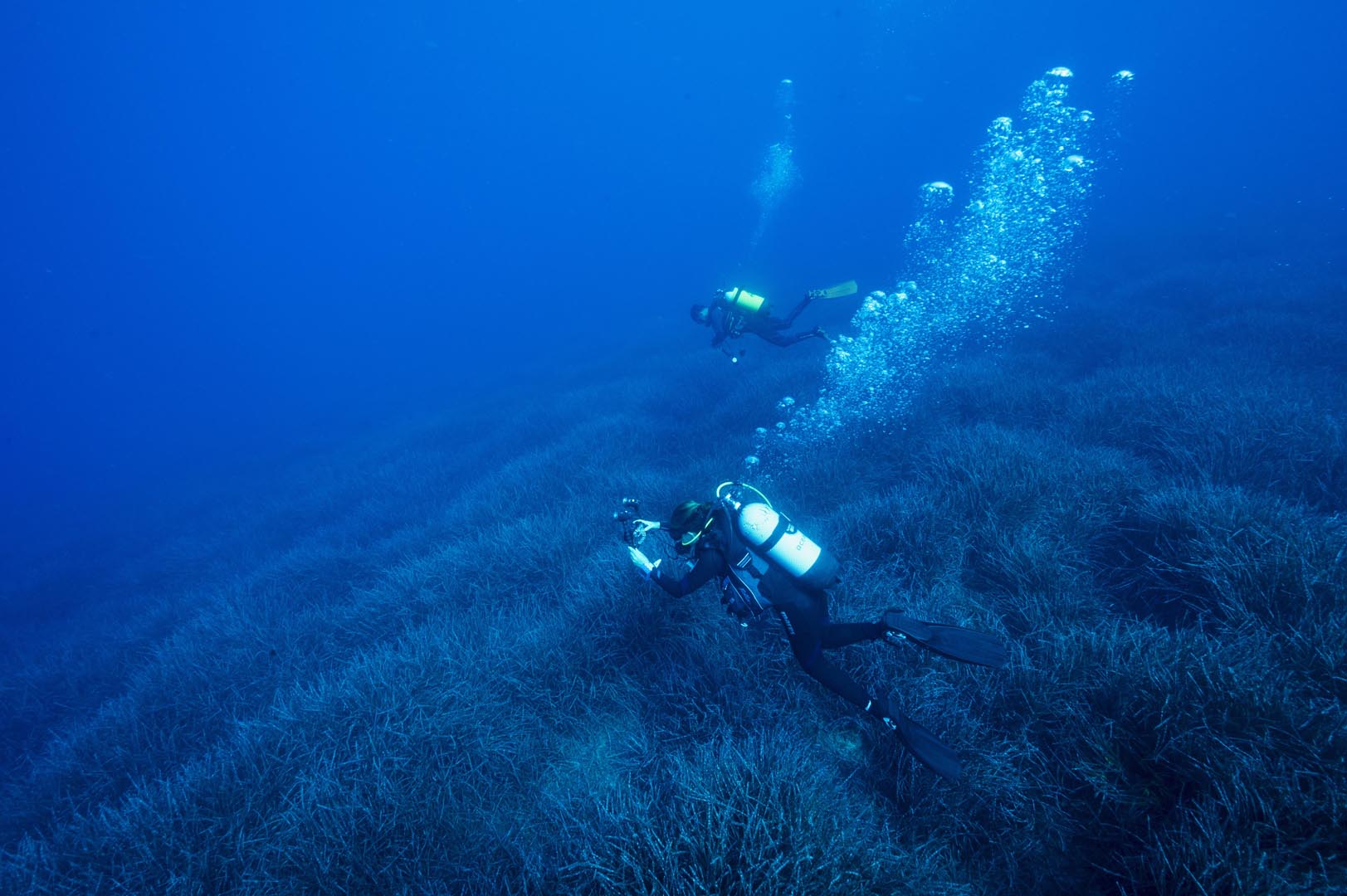
Seagrass meadows are flowering plants that are widely scattered globally, and that have adapted to live rooted in the ocean floor (sediment). They form structures resembling roots, stems, and leaves, anchoring themselves to the seabed and producing their own food through photosynthesis with the help of sunlight. As a result of photosynthesis, they serve as a source of oxygen and nutrients in the oceans and provide critical spawning grounds for many fish species that lay their eggs among these plants. The formation and development of seagrass meadows take many years. Scientific studies have shown that attempts to artificially replant seagrass meadows have not been successful.
In the Mediterranean Basin, species such as Posidonia oceanica, Cymodocea nodosa, and Zostera noltii are prevalent.
Posidonia oceanica is endemic to the Mediterranean. It forms extensive underwater meadows that grow on rocks and sandy bottoms in clean water at a depth from less than 1 meter to over 40 meters. However, recently they have been stuck between 10-30 m depth in our coasts.
Posidonia oceanica is strictly a marine species and is never found in estuaries or saltmarshes. Posidonia oceanica is a large, slow-growing seagrass with wide and persistent rhizomes. They form dense green meadows whose leaves can attain 1 meter in height during summer. Old leaves are shed throughout the year, but shedding intensifies especially in the autumn. Meadow density is maximal in shallow water and decreases exponentially with increasing depth.
Posidonia oceanica meadows can support a relatively wide range of temperatures, as deduced from the wide latitudinal range of its distribution. Therefore, although there are not specific experiments conducted, from this latitudinal distribution we can deduce that the plant endures temperatures from approximately 10°C-29°C.
Since visibility is crucial for photosynthesis, Posidonia oceanica needs transparent, oligotrophic, and oxygenated waters to survive. Vertical distribution of Posidonia oceanica is limited by light. It also supports a narrow range of salinity between 33-39‰ however it is possible that East Mediterranean Basin populations may support higher salinity.
The seagrass uses its roots to attach to the seabed and take up nutrients.. Sediment must be relatively anoxic. Posidonia oceanica can grow on rocky or sandy bottoms. Muddy substrates are not suitable as the plant is unable to attach itself and the water is too turbid for plant growth. The sedimentation and erosion balance also often limits meadow development. Posidonia oceanica never grows near river mouths or in confined waters (e.g. hypersaline coastal lagoons). Wave action is another important criterion: in sheltered bays, meadows can grow up to the water surface, forming coastal reefs, but in open coasts they usually start growing several meters below the surface.
Some species indicate seagrass perturbation: the overgrowth of epiphytic algae, and especially the episodic formation of dense mucus layers of filamentous algae (Ectocarpales and Crysophyceae) on the meadow canopy is associated with water eutrophication and reduced hydrodynamics. The green algae Caulerpa spp invade declining sparse meadows, especially when the sediment is enriched with organic matter. When nutrient inputs to the bed are very dense, sea urchins (normal densities 0-5 urchins m²) become over abundant (may attain 30 urchins m²) on meadows that grow near rocky substrates and consequently overgraze Posidonia oceanica leaves. An invasive sea urchin, Diadema setosum, has the same effect on Posidonia oceanica leaves. Therefore, if their numbers increase excessively, they can take on an invasive role and cause leaf and even habitat loss.
Species Living in Seagrass Meadows Habitat
A conspicuous and complex epiphytic community lives on the leaves of Posidonia oceanica. Within this community there are more than 94 species identified as micro and macro algae. More than 44 species of sessile animals such as hydroids have also been identified, and more than 90 species of accumulating bryozoans have been found, which are also a common component of the leaf epiphytic community. The presence of the large fan mussel Pinna nobilis, listed as "Critically Endangered" (CR) on the IUCN Red List (due to their filter-feeding habits, long lifespans, and slow growth), is a good indicator of water quality and mechanical stability within the meadows.
More than 70 algae (mostly red algae) species are identified which adapted low levels of light density colonized Posidonia oceanica rhizomes. 185 species of molluscs and 120 species of crustacea (copepod, decapod, and amphipod) are the most abundant faunal groups in Posidonia oceanica meadows. The Polychaeta are very abundant; more than 180 species are identified in the meadows. Sponges are abundant in the rhizome substrate (more than 15 species). Echinoderms are sea cucumbers 16 species of which are described that play a significant ecological role as sediment filterers.
Seagrass meadows provide a refuge for fish species. Many fish species are living in the meadows until they reach adulthood. The herbivorous green turtle Chelonia mydas feeds on tender seagrass leaves.
Why Are Seagrass Meadows Important?
Seagrass has the highest carbon storage capacity amongst all plant habitations in the world with 2000 tonnes/ha. Posidonia oceanica is the most significant type of seagrass in terms of primary production, and exists only on the Aegean and Mediterranean coastlines as it is a species endemic to the Mediterranean. It is a perennial species that has spread up to a depth of 45 meters on the Mediterranean coast, and can live up to 30 years. The existence of seagrass is an indicator of a clean sea. Despite being in the “Least Concern” category in IUCN’s Red List, the species’ population is on the decline.
Seagrass meadows oxygenate coastal waters, producing a net oxygen release to the atmosphere above the meadows. Due to the slow decomposition of lignified rhizomes and roots, the reef structure, and their matte acts as a long-term carbon storage. The leaves and rhizomes increase the surface available to sessile species and offer shelter to mobile species, thereby sustaining a diverse community. Posidonia oceanica beds are especially valuable as breeding grounds for several commercial species.
Blue Carbon is captured carbon by the oceans and coastal ecosystems. Posidonia oceanica plays a significant role in capturing carbon. They are known as Blue Carbon Storage and have the capacity that makes them important for mitigating climate change. Despite their importance, seagrass is disappearing and its decrease in quality also affects its capacity to sequester and accumulate carbon. Posidonia oceanica meadows provide, acting at the local scale, nutrient cycling, sediment stabilization and wave height reduction that helps protect the coast from storm damage and disturbances. On a global scale, seagrass meadows play an important role in helping mitigate climate change through the removal of carbon dioxide from the atmosphere and the subsequent storage of organic carbon in the underlying sediments for decades, to centuries and millennia. In the Mediterranean Sea, the global importance of Posidonia oceanica meadows as a long-term carbon sink have been widely accepted due to its extensive aerial extent and the large amount of organic carbon stored in their matte.
Are Seagrass Meadows Protected?
90% of seagrass habitats in the Mediterranean have been damaged. The acceleration of the decrease in the population of seagrass, which is vitally important for underwater life, is due to various factors including boats casting anchor and dredging on the grass, invasive seaweed species such as Caulerpa taxifolia, overfeeding in fish farms, damage to shores (in the form of building and road, marina, port construction) , the cleanup of seagrass due to complaints from holiday home owners claiming it bothers them when they swim, and the obstruction of sunlight due to the water’s surface being blocked by ghost nets and other debris.
Threats to seagrass meadows
- Anchoring of boats
- Bottom trawling
- Sedimentation
- Erosion
- Eutrophication (Seawater and sediment)
- Salinity increase (Water treatment plants)
- Algal invasive species and invasive herbivores
- Climate change (Sea water temperature)
- Marine pollution (plastic, bilge water, urbanization, etc.)
- Coastal destruction (coastal development)
- Tourism pressure (sand filling, beach, marina and port constructions, etc.)
What can be done to protect seagrass meadows?
- Protection of the meadows against bottom trawling and other illegal fishing activities.
- To establish buoy/mooring systems to prevent anchoring.
- Management of marine litter (inc. sewage treatment systems).
- Take action to control and combat alien invasive species.
- Prevent the introduction of organic matter.
- Ecosystem restoration actions (e.g. creating No Take Zones)
- Monitoring the Posidonia oceanica meadows.
- Regulation and enforcement.
What are we doing as the Mediterranean Conservation Society?
The Mediterranean Conservation Society establishes monitoring stations to determine the distribution and development of the Posidonia oceanica species. Through ghost net cleanup efforts, fishing gear and other solid waste that cover seagrass beds, reducing light and oxygen permeability, are being removed from this habitat. In addition, we are investigating the rate of Blue Carbon in the sediment of seagrass meadows. Through the Marine Ranger System, it warns boats not to anchor in seagrass beds within Marine Protected Areas. Its awareness campaigns aim to increase knowledge about the species.
Akdeniz’de Deniz’in akciğerleri Deniz çayırları tehdit altında!
References:
Akçalı, B., Kaboğlu, G., & Güçlüsoy, H. (2019). A review on Posidonia oceanica (Linnaeus) Delile coverage along the Turkish coasts until 2019. Journal of the Black Sea/Mediterranean Environment, 25(1).
Pergent-Martini C., Rico-Raimondino V. & Pergent G. 1994. Primary production of Posidonia oceanica in the Mediterranean Basin. Marine Biology 120: 9–15.
Monnier, B., Pergent, G., Mateo, M. Á., Clabaut, P., & Pergent-Martini, C. (2022). Quantification of blue carbon stocks associated with Posidonia oceanica seagrass meadows in Corsica (NW Mediterranean). Science of The Total Environment, 838, 155864.
Pergent-Martini C., Pasqualini V., Pergent G. & Ferrat L. 2002. Effect of a newly set up wastewatertreatment plant on a marine phanerogam seagrass bed - A medium-term monitoring program. Bulletin of Marine Science 71: 1227-1236.
Pasqualini V., Pergent-Martini C., Clabaut P. & Pergent G. 1998. Mapping of Posidonia oceanica using aerial photographs and side scan sonar : application off the Island of Corsica (France). Estuarine, Coastal and Shelf Science 47: 359-367.
Díaz-Almela E. & Duarte C.M. 2008. Management of Natura 2000 habitats. 1120 *Posidonia beds (Posidonion oceanicae). European Commission
Marbà, N., Díaz-Almela, E., & Duarte, C. M. (2014). Mediterranean seagrass (Posidonia oceanica) loss between 1842 and 2009. Biological Conservation, 176, 183-190.
Pergent-Martini, C., Pergent, G., Monnier, B., Boudouresque, C. F., Mori, C., & Valette-Sansevin, A. (2021). Contribution of Posidonia oceanica meadows in the context of climate change mitigation in the Mediterranean Sea. Marine Environmental Research, 165, 105236.
Abadie, A., Pace, M., Gobert, S., & Borg, J. A. (2018). Seascape ecology in Posidonia oceanica seagrass meadows: Linking structure and ecological processes for management. Ecological Indicators, 87, 1-13.
Montefalcone, M. (2009). Ecosystem health assessment using the Mediterranean seagrass Posidonia oceanica: a review. Ecological indicators, 9(4), 595-604.
RAC/SPA - UNEP/MAP, 2014. Field Manual for Monitoring of Posidonia oceanica Seagrass Meadows (Posidonia Meadows). By Prvan M., Jakl Z. and Guala I. Ed. RAC/SPA - MedMPAnet Project, Tunis. 12 pages.




